|
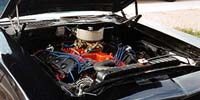
The
340 Engine.
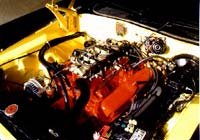
The
440+6 Engine.
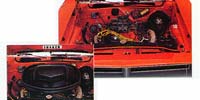
The
Shaker.
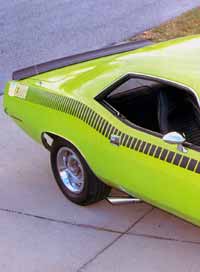
The Plymouth 'Cuda AAR
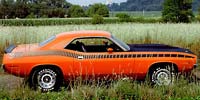
|
The Plymouth Barracuda of 1970 :
For 1970, the Barracuda was all new. Along with the Challenger,
the Barracuda launched the short lived E-body line-up.
The E-body was essentially a shortened wheelbase 68-70 B-body. That
is why the suspensions and engine compartments are almost alike. Everything
behind the front fenders is unique to the E-body.
Well, with the styling change, Chrysler dropped the fastback, but
retained the hard top and convertible. And thus began the more popular
generation of the Barracuda.
Also with the demise of the A-body, came the demise of the Formula
"S".
The base 'cuda came with the 335 hp 4-bbl 383 big block engine. But
that was just the beginning. If you were willing to part with a few
more bucks, you could have four other engines. The first step up was
the 275 hp 4-bbl 340.
People usually assume that the 340 was the base engine because it
was a small block putting out less power than the 383. But in actuality,
the 340 torqued up a lot quicker than the 383, and there was considerably
less weight to pull around, which helped straight line acceleration
and cornering ability immensely
This made the 340 'cuda the best overall performance package of any
'70 'cuda offered, except for the AAR.
The next step up was the 440 block, which you could have in either
375-hp 4-bbl form, or the 390 hp 6-bbl version. The king of the hill
was the 425-hp 426 Hemi engine.
These cars also got stiffer suspensions, and the Hemis came with 15"
rims as standard.
The 440 6-bbl has always played second fiddle to the Hemi in the public's
perception, but the truth is that it was just as fierce a competitor
on the strip, and could whip the Hemi between street lights. This
is because, like the 340, the 440 torqued up quicker than the Hemi.
And torque is correlated to acceleration. Power, which the Hemi had
more of, correlates to speed.
So between two identically prepared 'cudas, differentiated only by
the block, the 440-6 would jump out in front. The Hemi car will only
catch it over a significant distance.
The Hemi 'cudas came standard the Cold Air Grabber (commonly known
as the shaker hood). On the Hemi, bringing the cold air in could mean
as much as a gain of 20 horsepower. Most shakers in '70 were textured
silver, except for red cars, which got red shakers. The shaker was
also standard on the AAR.
Standard on the others was the beautiful performance hood. It came
with two non-functional scoops that covered most of the hood, and
looked enormous from the passenger compartment.
Cars equipped with the shaker, or the 440-6, were not available with
air conditioning, because the compressor could not co-exist with the
air cleaner.
If you wanted, you could even get your front, or both, bumpers covered
with urethane and painted body color.
More in the way of the appearance of the beast were options for a
rear spoiler, and the window louver package, which also included a
black vinyl top and textured window chrome, which was painted black.
Road lamps below the front bumper came standard. The dual exhaust
actually exited through two cutouts in the rear valence panel. The
tail light panel was painted an ominous black.
Sales were much improved over 1969. Just over 17,000 'Cudas were built
in '70, including the convertibles and the AAR's. And there was more
to come in '71. The AAR 'Cuda was a mid-year addition announced by
Plymouth in February.
The AAR was without a doubt the most complete package of style, straight-line
performance, and handling that Chrysler built during the muscle car
era. The AAR was produced only for 1970, in order to compete with
GM, Ford and AMC in the popular Trans-Am series. To qualify for the
series, Plymouth had to build a minimum of 2,500 street versions that
shared most of the race cars' components. Plymouth actually wound
up building 2,724 AAR's. The AAR's engine was putting out 15 more
horses than a stock 340. About that advertised 290 horses, don't believe
it. It was more like 325!
|




























